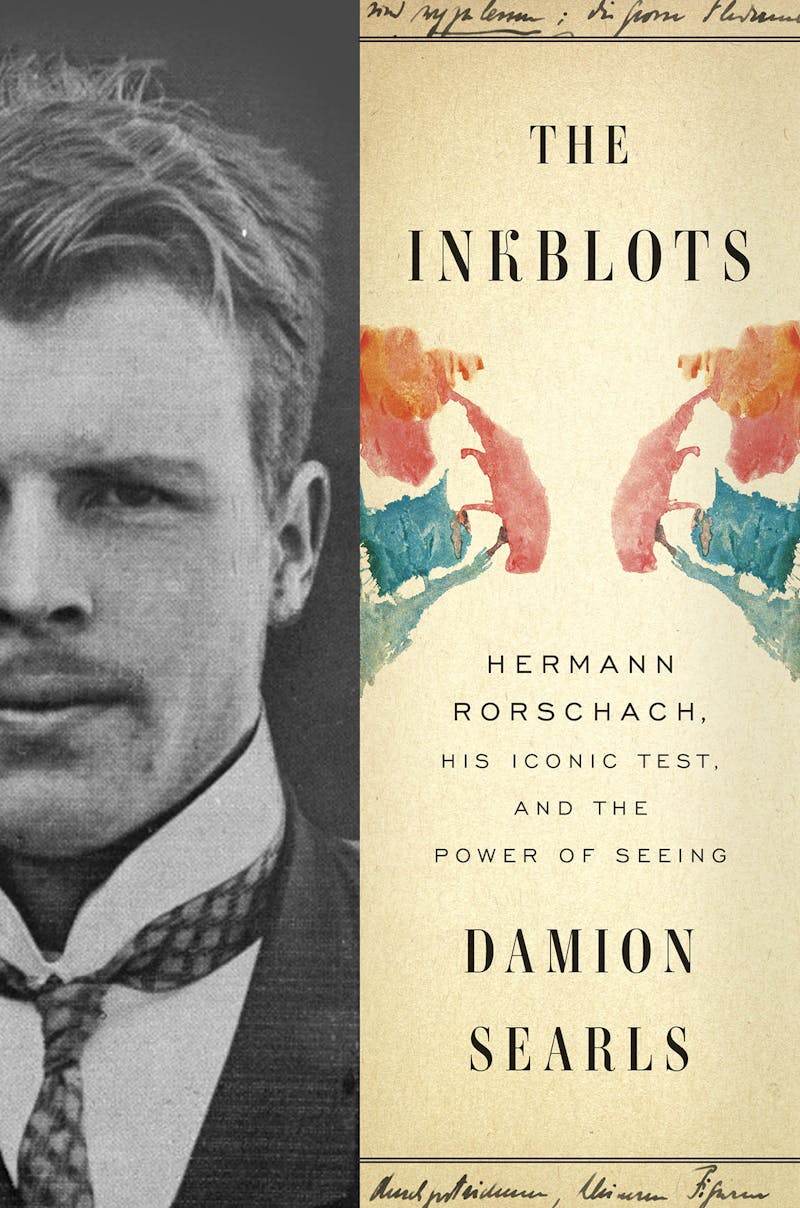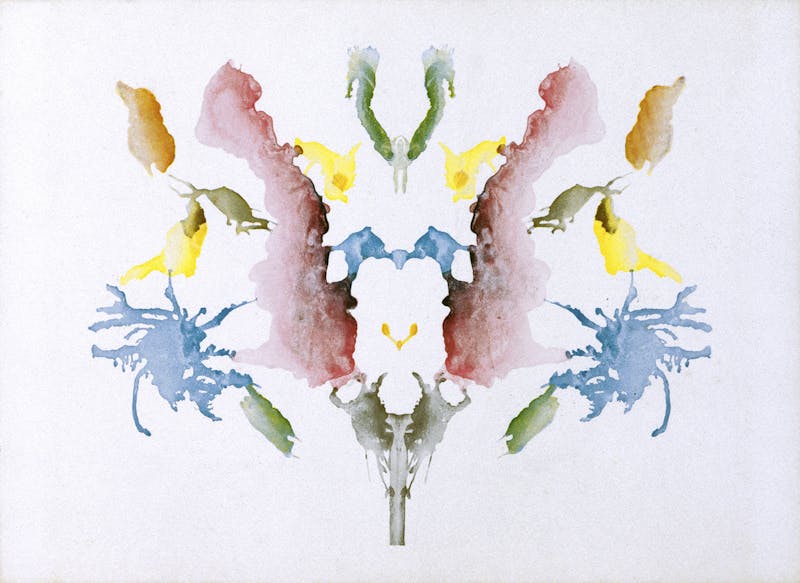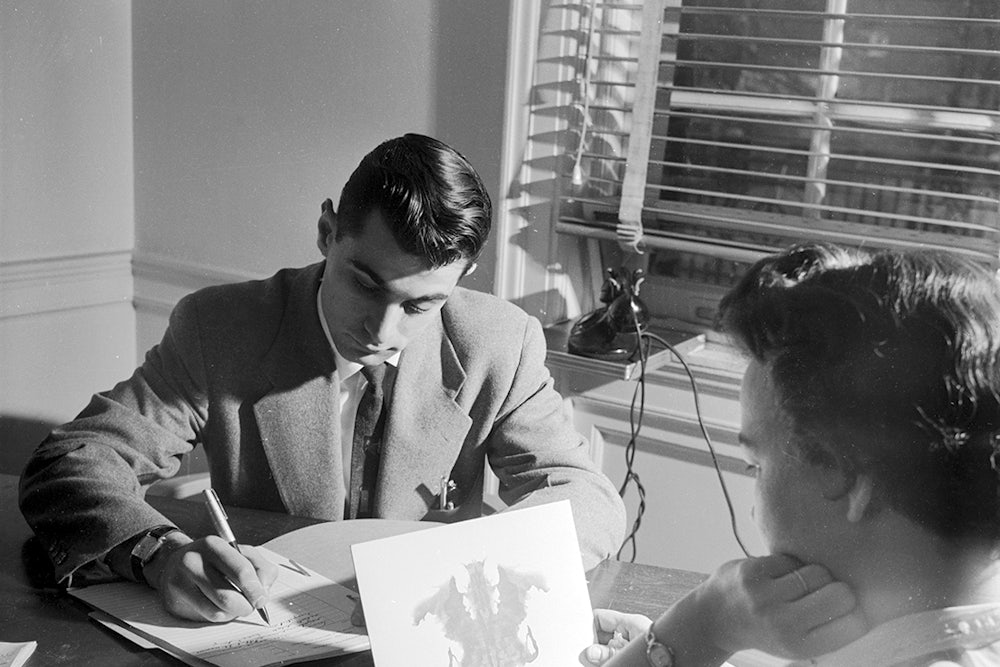Just after April Fools’ Day in 1922, Hermann Rorschach, a psychologist who used a collection of symmetrical inkblots to treat patients with manic depression and schizophrenia, died of appendicitis in Herisau, Switzerland, at the age of 37. Had he lived, he would have been 40 when his inkblots made landfall in the United States in 1925; 55 when they emerged as a helpful tool for profiling college applicants; 62 when the Pentagon used them to fashion a line of tropical shorts for World War II veterans; and 99 when Andy Warhol poured paint onto a canvas in 1984, folded it in half, and opened it to reveal his first inkblot-inspired painting. Rorschach would have been 121—unlikely, but not impossible—when Gnarls Barkley released his 2006 music video for “Crazy,” which featured a series of liquefied inkblots that morphed into threatening or reassuring shapes, depending on one’s perspective. And he most certainly would have been dead by 2016, when the film Arrival imagined a world in which aliens could communicate with humans by means of a visual language written in a mysterious, inky pattern.
Over the past century, Rorschach would have seen his inkblots morph from an obscure therapeutic instrument into a nearly universal cultural meme, at once a familiar touchstone for art, music, film, and fashion, and a controversial test for assessing job applicants and prosecuting criminal defendants. Perhaps he would have wondered why his inkblots, once reserved for the assessment of patients with serious mental illnesses, should have emerged as the preeminent metaphor for the relativity of all acts of perception and the flexibility of all personalities. “I am like a Rorschach test,” Barack Obama proclaimed in a 2008 interview. “Even if people find me disappointing ultimately, they might gain something.” “I tell people that Donald Trump is a Rorschach test,” echoed Jared Kushner, Trump’s son-in-law, last year. “People see in him what they want to see.”
Damion Searls traces the long arc of Rorschach’s influence in his scrupulously researched new book, The Inkblots: Hermann Rorschach, His Iconic Test, and the Power of Seeing. Equal parts biography and cultural history, The Inkblots traverses Rorschach’s short and undramatic life in Switzerland, Russia, and Germany, and his inkblots’ far longer and more interesting afterlife in the United States, where they came to play a crucial role in postwar organizational psychology.
It was impossible for Rorschach to know, or even to dream, that his blots would play the outsize role that they did in the modern cultural imagination. When he first attempted to publish the test in 1918, he encountered a staggering series of obstacles: money (the publishers he approached wanted him to pay to reproduce the blots), a wartime paper shortage, and skeptical colleagues. When the blots finally appeared in Rorschach’s book, Psychodiagnostics, in 1921, they were rejected by German academic psychologists as crude and insufficiently theorized. Shortly thereafter, at the height of his professional uncertainty, Rorschach died.
The inkblots would have died with him, were it not for the child psychologist David Mordecai Levy, who, in 1923, translated Psychodiagnostics into English and taught the first U.S. seminar on the Rorschach. Gradually at first, and then with a rapidity that shocked the psychiatric community, Levy’s students and colleagues adopted Rorschach’s inkblots for testing the psyches of patients, college students, artists, army officers, and the “strange and mysterious” people of far-flung African and Asian nations. It was not long before everyone knew, more or less, the Rorschach protocol: A psychologist would quietly pass her subject Rorschach’s inkblots, one at a time; first the five black-and-white cards, then two with large splotches of red, and finally three multicolored ones. “Tell me what you see,” she would say, and wait for an answer.

What makes Rorschach’s test so intriguing is that, unlike questionnaires and other language-based approaches to personality assessment, the inkblots present the test subject with a visual task. The images, Searls explains, are designed to get “around your defenses and conscious strategies of self-presentation”—to clear a direct path from perception to the expression of personality. Upon seeing the blots for the first time, many people gasp. Others look away, ashamed. Some stammer secrets they have long repressed. For Searls, the blots are not only a helpful pseudoscientific instrument, they are also a testament to the power of the aesthetic in the Romantic sense of the word: a state and study of heightened perception, one that exists somewhere in between feeling and cognition.
Searls places the Rorschach test and its creator in the crosshairs of art and science, impressionism and empiricism, objectivity and subjectivity. Its language of interpretation is essentially a painterly language: The most important features of one’s response to the inkblots are Form (F), Movement (M), and Color (C). Form refers to the shape the test subject sees: a bat, a bear, two women standing back-to-back eating turtle soup. Movement registers how much motion the client ascribes to these forms. The more Movement suggested in the answer—the bat shrieking, the bear dancing, the women lifting the spoons to their lips—the greater a person’s “psychic inner life,” Rorschach claimed. Color measures a test subject’s reaction to the sudden appearance of red, blue, and green in the last five blots. Subjects whom Rorschach considered exaggeratedly emotional—hysterics, neurotics, artists—tended to react more strongly to the colors. Some even experienced “color shock,” a near-catatonic state. The science of the Rorschach, to the extent that one can refer to it as a science, is a science of artistic response as the key to personality.
To achieve their desired responses, the blots themselves had to function like works of art—an unusual ask for a psychological test. Rorschach was not the first or even the second to try his hand at designing inkblots. Klecksography, the study of inkblots or “blotograms” as they were once called, originated with the German poet and physician Justinius Kerner. Unlike Rorschach, Kerner was neither a scientist nor an artist but a mystic. He believed his inkblots to be “incursions of the spirit world,” magical images that spoke to him in the voices of the dead; voices he ventriloquized in the gloomy poetic captions he added to his blots. More popular than Kerner was the French psychologist Alfred Binet, who drew his inspiration for his inkblots from Leonardo da Vinci, who, it was said, had once thrown a bucket of paint at a wall and divined his next painting from the shapes he saw before him. In keeping with this backstory, Binet’s inkblots—messy, asymmetrical things—were used to measure a person’s imaginative capabilities: the greater the number of distinct forms the respondent saw in the inkblots, the greater his creative powers.
By contrast, the power of Rorschach’s inkblots derived in large part from their painstakingly crafted designs, refined through much clinical trial and error to give them the appearance of naturalness—as if the shapes had not been crafted at all, but rather “had made themselves,” Searls writes. The point was neither disordered inspiration (as it was for Binet) nor spiritual connection (as it was for Kerner), but technical perfection. There could be no trace of the artist’s hand in the thickness of the brushstrokes or the shading of the ink; nothing to rouse suspicion among Rorschach’s paranoid patients that the inkblot had been created to elicit a particular response from them. There could be no captions, no border, nothing to distract respondents from the lines, the curves, the colors. Only the aesthetic impersonality of the blot could reveal the personality of its viewer.
To some degree, all personality assessment, whether visual or verbal, stalls at the uneasy intersection of art and science. A stylized language is designed, tested, altered, and retested until it evokes a consistent and verifiable response from its test subjects. The work of the personality assessor is not unlike the work of the writer or the editor or the artist, even if their ends are vastly different. Yet Rorschach was the first to imagine that the test itself might be an art form, that it would exhibit a “pictorial quality” that would transcend the genre of the test.
When the Rorschach test burst onto the American scene in the 1940s, it seemed wholly different from other personality tests, or “people-sorting instruments,” as they were then called without a trace of irony. With the rise of the labor force during and after World War II, corporations had warmed to the idea of using cheap, standardized tests to fit workers to the jobs that were right for them, a match made under the watchful eyes of executives eager to keep both profits and worker morale high. In this late-capitalist pursuit, they were guided by tests like the Personality Inventory, the Personal Audit, the Myers-Briggs Type Indicator, and the Humm-Wadsworth Scale, all of which promised to help corporations manage the influx of millions of new workers into the workforce, most of whom were women and veterans who had enrolled in college after the GI Bill passed in 1944. Next to these tests, the Rorschach seemed to be something else entirely: not a mechanism for sorting people, but an occasion for self-expression—more like “art therapy,” observed an early Rorschach adopter, than a multiple-choice questionnaire.
We do not tend to think of personality tests as akin to works of art: unique, complex, irreducible, infinitely signifying. The opposite is often the case. Since their efflorescence in the 1940s, personality tests have often been used to identify individuals as specific “types,” initiating them into vast systems of social bureaucracy. Individuals were encouraged to think of themselves as examples of more general and generic models of human beings, who, taken together, made up a well-ordered social whole.

There was a darker side to “people sorting” as well. By the time the Rorschach test was a cultural icon in America in the late 1930s, German authorities had begun planning the sorting and deportation of Jews from the Lodz ghetto to the Chelmno concentration camp. Theodor Adorno would make the connection between the management of minorities and the management of workers explicit in The Authoritarian Personality, which offered a blistering critique of personality typing and testing. “It cannot be doubted that the critique of psychological types expresses a truly humane impulse, directed against that kind of subsumption of individuals under preestablished classes which has been consummated in Nazi Germany, where the labeling of live human beings, independently of their specific qualities, resulted in decisions about their life and death,” Adorno wrote. “The rigidity of the construction of types is itself indicative of … the potentially fascist character.”
Of course, personality testing did not create this state of affairs, it only consecrated it. For Adorno, type and its “people-sorting instruments” were not the real problem, they were merely a symptom of a more invasive psychological disease: social modernity. The rise of industrial capitalism and the division of people into classes—owners versus workers, white-collar versus blue-collar—had left an indelible imprint on the souls of men and women, stamping a standardized way of thinking, feeling, and behaving onto their psyches. Those who believed in the sanctity of the individual had been conditioned to do so by their class position. If you worked a managerial job, the kind that stressed creativity and gumption and “thinking outside of the box,” you would be more inclined to think of yourself in such individualistic terms. A line worker, a mere cog in the machine, had not been initiated into this language of self-actualization because he had no profitable use for it on the factory floor. “There is reason to look for psychology types because the world we live in is typed and ‘produces’ different ‘types’ of persons,” Adorno wrote. “The critique of typology should not neglect the fact that large numbers of people are no longer, or rather never were, ‘individuals’ ”—people who enjoyed real “freedom for action.” (One cannot imagine the existence of the BuzzFeed quiz in a world without such mass cultural artifacts as fast food, Friends, Harry Potter, and Taylor Swift.)
The Inkblots, however, does not take its critical cues from Adorno. Searls wants to redeem the Rorschach test, whether scientifically valid or not, as a technique of the self—an “art of existence,” as Michel Foucault would have it. Should one choose to believe in it, the psychological knowledge that the test offers provides a way of caring for the self, of managing one’s thoughts, feelings, conduct, and way of being to attain a certain state of perfection, happiness, or well-being. By this measure, what is important is not exclusively the Rorschach test’s aesthetic presentation, but what happens in the process of administering it: a dialogue between a psychologist and her subject in which the subject can articulate her impressions, listen to the psychologist’s interpretation, and upon hearing this interpretation—“You are introverted, imaginative, stable”—embrace the language of the self with which she has been presented. She can feel comfortable dwelling in her imagination, eschewing drama, embracing quietude. With the help of the test, she can accept this version of herself as her true self.
In a sense, the Rorschach may be more hospitable to an art of existence than tests with sternly categorical schema, like the Enneagram or the Myers-Briggs Type Indicator, insofar as it does not slot the individual into a predetermined and fixed set of categories, but seems to offer a looser, less constrained assessment of one’s personality. This may explain its appeal to creative types. The fantasy of the expressive creation of the self has become so naturalized by writers, poets, musicians, and painters that the Rorschach test must strike them as a totem of artistic freedom.
In Searls’s preoccupation with the Rorschach’s aesthetic valences, a second-order truth emerges. Writing about the Rorschach test is itself a projective exercise; one that often reveals as much about the writer as it does about the test. Searls seems to have no interest in either confirming or disproving the test’s validity as a diagnostic tool. He is not a cynic; The Inkblots is not an exposé. He is an aesthete, and to him the greatest value of the blots is as art objects. “The blots look great,” he proclaims again and again throughout the book, as he details how their forms inspired visual artists from Warhol to Alan Moore, from Barkley to Jay Z. “They just look good.” At moments, Searls’s words fail him and a sort of mysticism takes over—a feeling of pure aesthetic bliss emanating from the blots. “You can feel the answers coming at you from the image. There’s something there,” he insists. There is something there, of course. Yet it is difficult, maybe impossible, to know ultimately whether that something is in the blots or in his mind. Intended or not, the history of the Rorschach test that emerges from Searls’s account is, ultimately, a Rorschach test.
